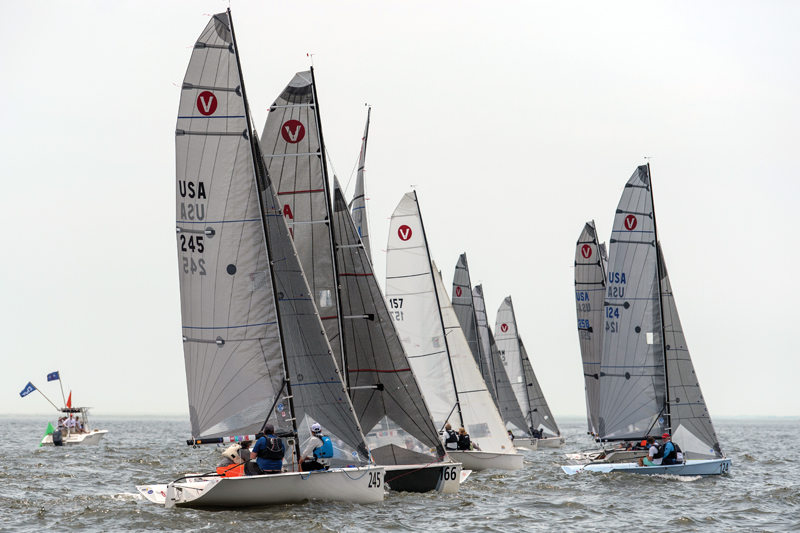The decision to cover, or not, on the upwind leg of a sailboat race
If things are going pretty well for you on the sailboat racecourse, you’re likely ahead of a few boats. When you cross paths on the windward leg while on opposite tacks (and you’re ahead), that sets you up to make some decisions: Should you tack to cover them… and if so, how?

Two primary ways to cover
To oversimplify a bit, covering is maneuvering your boat so that you are between your competition and the weather mark or weather finish line. There are two primary ways to cover: tight and loose.
In a tight cover, you tack into a spot ahead and slightly to windward of the boat you are covering so that they are in your wind shadow. You must be within a few boat lengths and situated so that your apparent wind affects them. If their masthead fly is pointing at you, you’re in the right spot! This position not only helps you stay in front of them, but it also may help you increase your lead by giving them dirty air.
In a loose cover, while you are still between your competition and the mark, you are not aggressively stealing their breeze. Instead, you are often to windward with your bow closer to even with their bow, more abeam of them than in front of them. This is a kinder, gentler cover: You are in touch with them, but you are not affecting them (except probably mentally!). Tacking into this spot requires looking over your shoulder to make sure you have let the other boat progress forward enough so that you aren’t tacking onto their breeze.
The two different types of covers have very different flavors: Tight is aggressive and offensive; loose is collaborative and defensive. As such, they are used in different situations. How best to apply these two actions?
Tight cover
Putting a tight cover on another boat makes them choose between two undesirable options—tacking away or sailing in your bad air. If you want them to go the other way or to slow down, this is the right thing to do.
For example, if they are near layline, and you would prefer to have them tack short of layline (thus forcing them to do two extra tacks), a tight cover can make that happen. Another spot is if you are sailing on a header: Tacking into a tight cover on them would then force them to tack onto that header (you’re essentially swapping spots) or sail in your dirty air if they want to continue on the lifted tack. A tight cover can also encourage a “lone ranger” boat to tack back toward the pack if you’d like to herd the group back together again.
But note—tight covers are aggressive actions. They are not for frequent use. Apply this option too frequently, and you’ll get a reputation—and not a good one. Last leg of one of the final races of a series? Sure, use it. Racing to determine who will represent your country at an international regatta? Okay. First leg of a weeknight series? Nope.
Loose cover
Covering a competitor loosely is more like gently herding them in a direction of your choosing. Because you are not affecting their wind, they can continue unhindered.
Essentially, use a loose cover if you don’t want them to tack. This might be if they are part of a larger group of boats that you want to keep together—and keep in front of. By loose-covering, you stay in touch with (and in front of) them but don’t scatter them due to some deciding to tack and others not.
Think a bit ahead on your positioning, too. If you anticipate that, while you are loose-covering, you and the boat(s) you are covering will sail into a lift, know that you will essentially be even more ahead of them. But if you sail into a header, depending on how far ahead of them you were to start, they may eventually be able to tack and cross you.
Another option
Remember, just because you can apply either a tight or loose cover doesn’t mean you should! Are you sailing toward the favored side of the course, while a boat you are crossing is headed off into la-la land with less breeze or unfavorable current? Let ‘em go! Is your boat speed superior, and you’re pretty close to the finish? Just send it and get there!
The decision to cover or not to cover upwind is one of the situations on the racecourse where decisions need to be made promptly. Thinking through all the options as the scene unfolds just doesn’t work. Gather your crew or other people who sail in your one-design class and talk through some situations. Having a plan in your back pocket can really help.
by Kim Couranz
About the Author: SpinSheet Small Boat columnist for more than a dozen years, Kim Couranz has earned several national and world titles in Laser Radials (ILCA-6) and Snipes. She has also raced J/22s, J/24s, and Ynglings on an international level.




